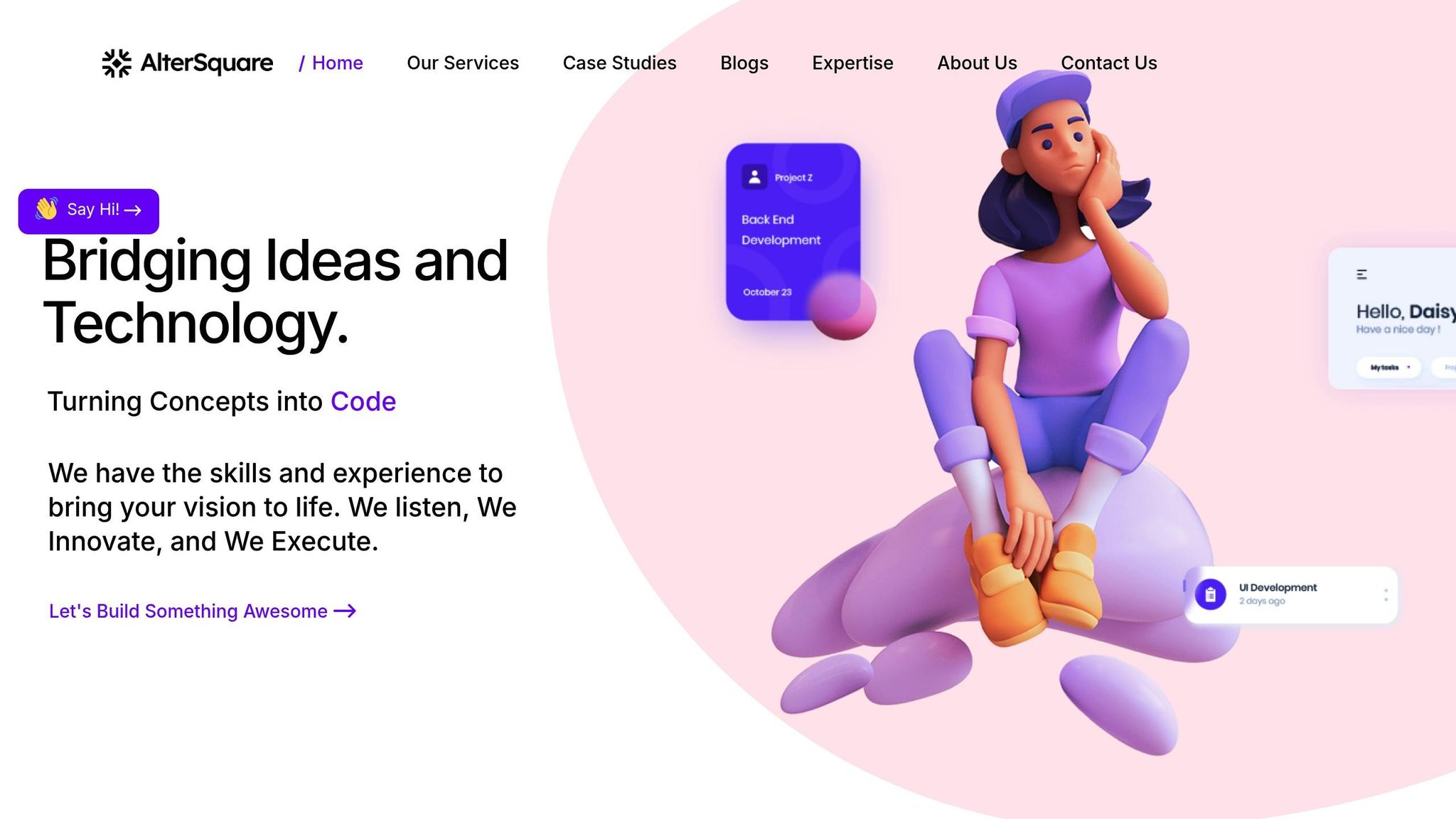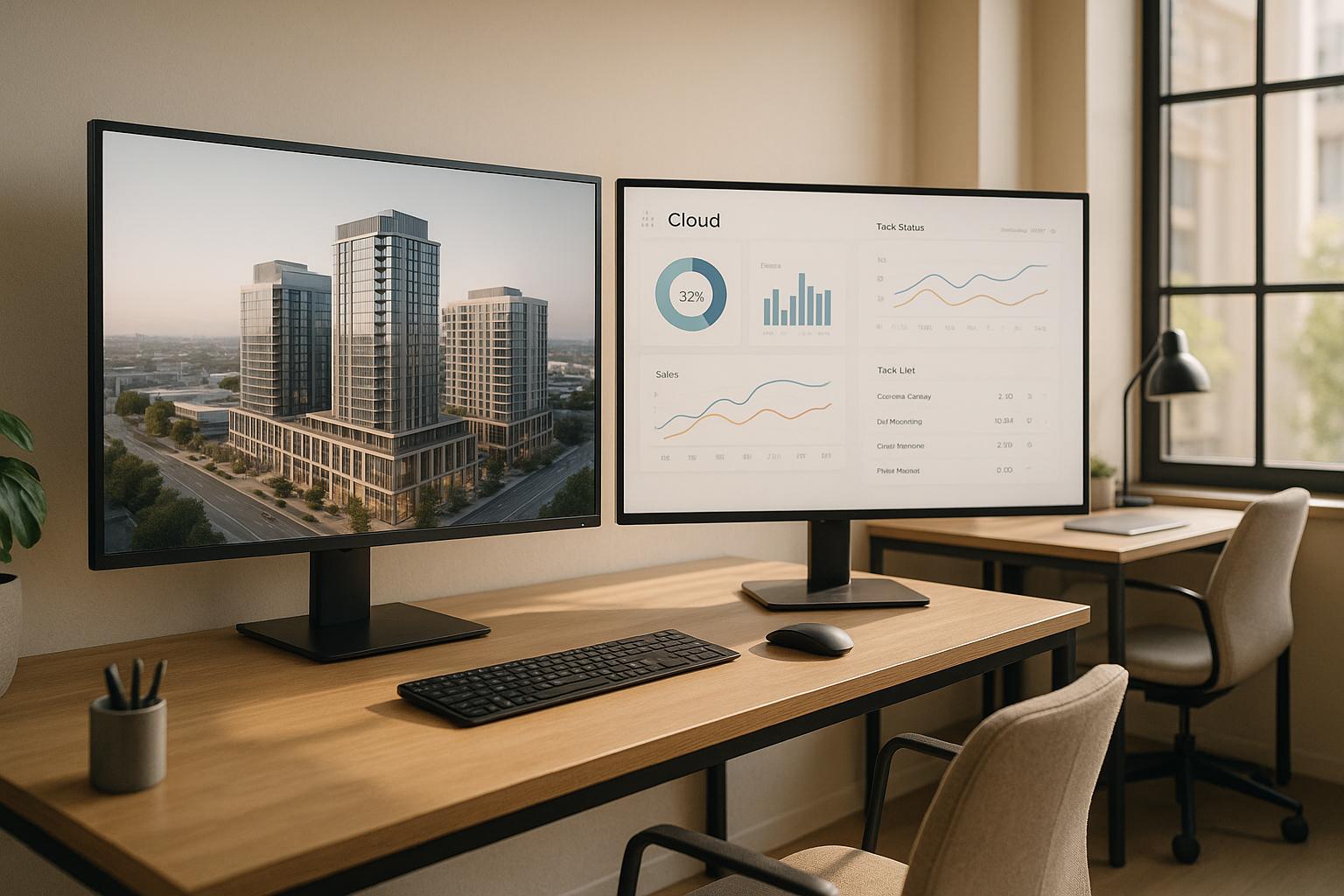Expansion MRR Playbook: Turning Single Projects into Multi-Year Contracts
Taher Pardawala July 30, 2025
Struggling with unpredictable cash flow from one-off projects? Expansion MRR (Monthly Recurring Revenue) offers a solution by driving revenue growth through existing clients. It’s cheaper to upsell current customers ($0.27 per $1) compared to acquiring new ones ($1.13 per $1). Multi-year contracts provide financial stability, reduce client churn, and foster long-term partnerships.
Key strategies include:
- Upselling and cross-selling services like feature upgrades or scaling support.
- Building trust through clear communication and milestone-based reporting.
- Structuring flexible contracts with retainer agreements, tiered packages, and fair termination clauses.
For MVP development, tools like CRM systems, project management platforms, and AlterSquare’s I.D.E.A.L Delivery Framework help manage long-term relationships effectively. By aligning technical work with client business goals, you can transition from short-term projects to reliable, recurring revenue streams.
How to drive expansion from your existing customers with the REACH Framework™
Building Client Trust and Delivering Consistent Value
Trust is the foundation of any lasting partnership. When clients see your work as essential to their success, they’re far more likely to commit to multi-year contracts. Earning this trust requires consistent actions and a clear focus on delivering measurable value.
Building Trust Through Clear Communication
Clear communication goes beyond basic updates – it’s about creating transparency and giving clients confidence in their investment. According to the Project Management Institute, ineffective communication is responsible for more than half of project failures [3].
One way to build trust is through milestone-based reporting. Instead of vague progress updates, break your MVP development into tangible milestones. Regular performance reviews that highlight both technical achievements and their business impact show clients how your work drives user engagement and supports their broader goals.
Establishing two-way communication channels is equally important. Encourage structured feedback and address challenges promptly with honest explanations and actionable solutions. This level of transparency not only strengthens credibility but also ensures your work aligns closely with the client’s objectives.
Delivering Value That Matches Business Goals
Once trust is established, the next step is delivering value that directly supports your client’s goals. When you understand their objectives, you shift from being a service provider to becoming a strategic partner. Inefficiencies can undermine business performance, so aligning your development efforts with their priorities is essential.
One effective approach is rapid prototyping. Instead of spending months perfecting code, create functional prototypes to validate key business assumptions quickly. Use metrics like Daily Active Users (DAU) and user retention rates to measure success. For instance, a successful MVP often sees DAU increase by 5–7% weekly, while achieving 25–30% user retention after 90 days signals a strong product–market fit [4].
Post-launch, your role doesn’t end. Continuous optimization of features based on user feedback and market trends ensures the product evolves to meet new demands. This ongoing support solidifies your position as a critical part of your client’s growth strategy.
Always connect technical tasks to business outcomes. Instead of presenting a feature as just another deliverable, explain how it enhances user experience or drives customer satisfaction – like improving the checkout process to boost sales.
Using agile methodologies with iterative development cycles helps you stay aligned with changing business needs. Sprint reviews and retrospectives allow for course corrections, while practices like automated testing and code reviews maintain quality. These efforts build your client’s confidence in your ability to handle increasingly complex projects, making you an indispensable partner.
When your work consistently drives results and aligns with your client’s success, long-term partnerships naturally follow. Multi-year contracts become less of a goal and more of a logical next step.
How to Structure Multi-Year Contracts
Drafting a multi-year contract takes thoughtful planning to balance stable revenue for your business with flexibility for your clients. Below, we’ll break down practical contract models and design tips to ensure long-term success.
Contract Models for Long-Term Work
Retainer agreements are a simple way to secure consistent monthly revenue. Clients pay a fixed fee each month for a pre-defined scope of work. For instance, this could include a set number of development hours, with any extra work billed at an agreed hourly rate.
Tiered service packages allow clients to scale their services as their needs evolve. A basic package might cover routine maintenance and updates, while a premium package could include advanced features, performance improvements, and dedicated support. This setup not only provides flexibility for clients but also creates opportunities for you to grow revenue as their needs expand – without requiring constant renegotiation.
Maintenance and support contracts are designed to ensure systems run smoothly. These contracts often come with lower fees but tend to have high renewal rates. Why? The hassle and risks of switching providers make them appealing for long-term partnerships.
In many cases, agencies mix and match these models. For example, you might combine a base maintenance fee with additional retainer hours. This approach ensures steady income while leaving room for project-based growth.
Contract Design Best Practices
Once you’ve chosen the right model, focus on crafting a contract that’s clear, flexible, and ready to adapt to future needs.
Flexibility clauses are essential. Include terms for periodic reviews, annual benchmarking, and mid-term performance checks. These features allow both parties to adjust the agreement as circumstances change, without constant renegotiation. As Imprint Events Group notes:
"Flexibility should be incorporated into the contract where possible. Including clauses that allow for periodic reviews and adjustments can help both parties adapt to changing circumstances without jeopardizing the overall agreement." – Imprint Events Group [5]
Annual benchmarking ensures pricing stays competitive. This reassures clients they’re getting fair market rates while giving you room to adjust as your expertise grows or market conditions shift [1].
Mid-term reviews – scheduled every six months – help assess performance and make adjustments as needed. These check-ins are a great way to catch potential issues early, whether it’s a scope misalignment or a pricing concern [1].
"By building flexibility and regular reviews into these agreements, businesses avoid overcommitment. This approach ensures multi-year deals remain assets rather than liabilities as markets and priorities evolve." – cloudeagle.ai [1]
Fair termination clauses are another must-have. These outline clear and agreeable exit terms, allowing both parties enough time to transition smoothly if the relationship ends.
Price protection mechanisms can help manage costs over time. For example, you might include annual price increase caps (commonly 3% to 5%) or expansion rate tables that define costs for adding users or services during the contract term [2].
Lastly, specify tools and systems for project management and communication. This ensures continuity and minimizes disruptions, especially when team members change or new stakeholders join the project.
The way you structure your contract plays a big role in your ability to scale. A well-thought-out agreement reduces the need for constant renegotiations [1] and sets the stage for a growing, long-term relationship.
sbb-itb-51b9a02
Upselling and Cross-Selling for MVP Development
Once your MVP reliably meets client needs, new revenue opportunities naturally arise. For agencies, this is the moment to transition from a one-time project to a lasting growth partnership. The trick lies in spotting when clients are open to additional solutions and offering the right extras at the right time.
Finding Upselling Opportunities
Upselling works best when you closely monitor how clients use your product or service. Look for patterns: Are they frequently hitting service limits? Do they repeatedly ask for similar customizations? These are clear signals that they might benefit from expanded options. For instance, a healthcare IT data service company in the U.S. boosted its average purchase size by 30% for new clients by identifying these moments [6].
Another way to upsell is by offering smarter tools like automation, personalization, or predictive analytics – features that justify a premium price. As startups evolve, they often need performance tweaks, scalability enhancements, or infrastructure upgrades. Similarly, user feedback might highlight opportunities to improve the interface or user experience, making a refreshed design an attractive upsell.
Timing matters. Clients are often most receptive to upsell offers after a positive outcome or when they express interest in additional features. Tools like Net Promoter Score (NPS) can help pinpoint the right moment to approach them. By adding tailored cross-selling to the mix, you can deepen these relationships while expanding the overall value you provide.
Cross-Selling Services to Different Client Types
Cross-selling complements upselling by addressing a broader range of client needs. To succeed, you’ll need to adapt your approach based on the type of client you’re working with.
- Non-technical founders: These clients care about business outcomes. Focus on how your additional services can drive revenue, improve user acquisition, or streamline operations. For example, when discussing product management or software consulting, emphasize how these offerings safeguard their investment and reduce risks down the line.
- Tech founders: This group appreciates technical depth. Dive into architecture upgrades, technology stack improvements, or ways to optimize development practices. Highlight your expertise in product engineering to naturally introduce related services.
- Seasoned founders: With prior experience, these clients often prioritize post-launch support or team augmentation. They’ve been through scaling challenges before and understand the value of ongoing support.
The numbers back up a strategic cross-selling approach. Around 74% of companies engaged in cross-selling report that it accounts for up to 30% of their revenue. Plus, loyal customers are five times more likely to repurchase and seven times more likely to try new offerings [7]. Bundling services can also work wonders. For example, a German bank used gamification to achieve a 105% rise in credit card sales and a 122% boost in investment savings plans [6].
Personalization is key. Research your client’s industry, growth stage, and specific pain points to make tailored recommendations. When framing your pitch, align it with their priorities – whether that’s boosting revenue for non-tech founders or improving development speed for tech-savvy clients.
Tools and Processes for Long-Term Client Management
Managing multi-year contracts effectively requires more than just good intentions – it demands the right tools and processes. Without them, even strong client relationships can falter due to miscommunication, missed deadlines, or a lack of project visibility. To maintain momentum and meet evolving client needs, a seamless workflow is essential. Below, we’ll explore key tools and processes that can simplify long-term client management.
Technology Tools for Better Collaboration
The right technology can make all the difference in managing long-term client relationships. Here are some essential categories and examples of tools that help streamline collaboration:
Customer Relationship Management (CRM) systems are indispensable for tracking client interactions, organizing data, and automating communication. Platforms like Salesforce, HubSpot CRM, and Zoho CRM act as centralized hubs, capturing every client touchpoint – from the initial conversation to contract renewals. Did you know that 91% of companies with more than 11 employees rely on a CRM system to stay organized? [9]
Project management tools ensure that multi-year engagements stay on track. For example, Asana excels at task assignments and timeline visualization, while Basecamp centralizes project discussions and information for both teams and clients. Monday.com offers flexible workflows that can adapt to changing project needs over time [8].
Communication platforms close the gap between teams and clients. Tools like Slack allow for dedicated client channels and instant updates, Zoom facilitates virtual face-to-face meetings, and Microsoft Teams combines messaging, file sharing, and video conferencing to keep everyone aligned without endless email threads.
| Tool Category | Popular Tools | Primary Function |
|---|---|---|
| CRM | Salesforce, HubSpot CRM, Zoho CRM | Manage client data and interactions in one place [8] |
| Project Management | Asana, Basecamp, Monday.com | Track tasks, timelines, and project progress [8] |
| Communication & Collaboration | Slack, Zoom, Microsoft Teams | Enable real-time communication and teamwork [8] |
| Data Analysis & Reporting | Google Analytics, Tableau, Power BI | Analyze client behavior and service performance [8] |
| Feedback & Surveys | SurveyMonkey, Typeform, Qualtrics | Collect and analyze client feedback [8] |
Beyond these categories, email marketing platforms like Mailchimp, Constant Contact, and Marketo help maintain consistent communication through newsletters and targeted campaigns. Meanwhile, feedback tools such as SurveyMonkey, Typeform, and Qualtrics gather client insights quickly and effectively [8].
"Great software is built on trust and collaboration. As a software development company, focus on delivering more than the contract." – Decipher Zone [10]
To further enhance client satisfaction, secure client portals and AI-powered tools for sentiment analysis can provide deeper insights into client preferences and improve communication [11].
Using AlterSquare‘s I.D.E.A.L Delivery Framework

While tools are essential, structured processes are equally important for long-term success. AlterSquare’s I.D.E.A.L Delivery Framework provides a comprehensive approach to managing extended client relationships. This framework is designed to maintain quality, meet deadlines, and keep clients engaged throughout multi-year contracts.
The I.D.E.A.L framework excels at breaking down complex, long-term projects into manageable phases. For example, startups building MVPs benefit from 90-day development cycles, which create clear milestones that clients can track and celebrate. This keeps the momentum going, even during lengthy engagements.
For growth-stage startups, the framework supports scalability by redesigning product architecture to handle increased demand without compromising core functionality. This ensures minimal disruption during transitions, which is crucial for maintaining trust in long-term relationships.
What sets I.D.E.A.L apart is its integration of technical delivery with broader business goals. Instead of simply fulfilling client requests, the framework aligns development efforts with the client’s strategic objectives. This is especially valuable as client needs shift over time.
Quality assurance is built into every phase, reducing risks and strengthening trust. Regular check-ins, progress reviews, and strategic planning sessions provide natural opportunities to discuss renewals, additional services, and evolving priorities.
The framework also includes proactive risk management strategies, which help identify potential issues before they escalate. Thorough documentation and knowledge transfer processes ensure continuity, even when team members change.
Lastly, the emphasis on rapid prototyping and iterative development keeps clients involved by providing regular updates and opportunities for feedback. This transparency prevents the disconnect that can sometimes occur during extended development cycles, reinforcing the foundation for lasting client partnerships.
Conclusion: Building a Foundation for Growth
Turning one-off projects into multi-year contracts is all about establishing partnerships that stand the test of time. The strategies in this playbook are designed to create a solid framework where both service providers and clients can thrive together.
At the heart of this foundation is trust, built through clear communication and transparent processes. When clients see you as an integral part of their team, renewals become a natural outcome.
As client needs shift, so must the contracts and services that support them. Delivering value isn’t static – it evolves just as quickly as client priorities. For example, what starts with developing an MVP can grow into scaling, ongoing technical support, or other services. Startups, in particular, experience rapid changes, and their needs in the first month can look entirely different by the twelfth.
Thoughtfully designed agreements with built-in flexibility, clear milestones, and transparent pricing reduce uncertainty while leaving room for growth. Models like performance-based pricing and phased delivery schedules create mutual benefits, ensuring that both sides succeed together.
When you’re deeply embedded in a client’s journey, opportunities for upselling and cross-selling emerge naturally. These aren’t forced – they’re the result of understanding the client’s evolving needs and delivering consistent value, which strengthens the partnership over time.
Consider this: with 90% of startups failing and 29% citing cash constraints before achieving product-market fit [12], the choice of a development partner can make or break their success. This creates a unique opportunity for providers who can prove their value and guide startups through their most challenging phases.
AlterSquare embodies this philosophy:
"At AlterSquare, we bring to you an augmented tech team that sells engineering as a service! We work with start-ups to build bespoke MVPs."
- AlterSquare
Their approach highlights how to transform effective MVP services into lasting partnerships. By offering 90-day development cycles, rapid prototyping, and post-launch support, they create natural opportunities to extend contracts and expand services. Their I.D.E.A.L Delivery Framework ensures quality and satisfaction across even the most complex, multi-year engagements.
Technology tools and processes – like CRM systems and project management platforms – play a crucial role in making long-term client management scalable. Without these systems, even the strongest relationships can crumble under the weight of extended engagements.
Growing expansion MRR takes patience, reliable delivery, and a deep commitment to client success. Businesses that master this approach don’t just increase their revenue – they become indispensable partners in their clients’ success stories. In an industry where trust is built through consistent delivery and relationships grow milestone by milestone, investing in long-term thinking pays off in ways that go far beyond a single contract.
FAQs
How can I turn one-time projects into long-term contracts with my clients?
To transform one-off projects into long-term partnerships, the key is earning trust and consistently delivering results that align with your client’s objectives. Show them how your services – like MVP development – play a crucial role in their ongoing growth and success. Emphasize the bigger picture, such as how collaborating long-term can lead to cost efficiency, scalability, and reliable support over time.
Another way to build lasting relationships is by offering flexible renewal options and crafting solutions that adapt to their changing needs. Proactively suggest additional services, such as maintenance, feature updates, or performance improvements, to demonstrate your commitment to their success. By presenting yourself as a strategic partner rather than just a service provider, you can solidify trust and lay the groundwork for multi-year collaborations.
What are the best ways to build trust and maintain clear communication with clients for long-term success?
Building trust and keeping communication open with clients are key ingredients for lasting partnerships. Always aim to be honest and upfront about everything – whether it’s project timelines, deliverables, or potential challenges. When you’re clear and consistent, it’s easier to make sure everyone’s on the same page from the start.
Stay connected with your clients through regular updates, personalized check-ins, and by involving them in important decisions. Responding quickly to their questions or concerns shows you’re invested in their success. Plus, taking their feedback seriously – and acting on it – helps reinforce a collaborative relationship built on mutual trust.
What are the best tools and practices for managing long-term client relationships and ensuring consistent value delivery?
To manage long-term client relationships effectively, Customer Relationship Management (CRM) tools play a crucial role. These platforms help organize client data and keep track of every interaction, making it easier to stay connected and responsive. Some of the most popular tools are designed to centralize communication and simplify workflows, ensuring nothing falls through the cracks. Regularly reaching out, asking for feedback, and being transparent are essential practices for building trust and nurturing strong, lasting partnerships.
Delivering consistent value requires a structured approach. Using templates and checklists can help maintain both quality and efficiency across projects. It’s also important to set clear goals and ensure deliverables align with what the client expects. Establishing feedback loops is another key step – it not only supports continuous improvement but also ensures projects stay on track and evolve alongside the client’s changing needs.








Leave a Reply